Menu

In modern agriculture, billions of data points are collected by smart combines. They use sensors to manage resources on farms better. Digital farming is changing agriculture. Tools like Climate FieldView™ mix farm and data science. They use satellite pictures to make farming smarter.
Soil sensors in the field help farmers check soil conditions quickly. Drones can spot plant problems early, thanks to their special cameras. These new tools are not just cool; they help with big issues like not having enough food and being more green.
Companies like ICL Group and Idroplan are using these new technologies well. ICL Group’s GROWERS platform gives advice based on data. This helps industry pros make better choices. Idroplan’s smart irrigation cuts down on water waste, boosting sustainable farming.
Using advanced digital tools makes sure we have enough food and take good care of the environment. It also helps farming cope with growing needs around the world. It makes agriculture smart and keeps it sustainable.
Agritech is tackling big issues like not having enough food, supply chain problems, and the need for eco-friendly farming. It’s making farms around the globe use new tech to be better for the planet and produce more.
Agritech uses high-tech sensors, data crunching, and satellites to farm smarter. This includes things like managing crops better, cutting down on waste, and using water and fertilizers wisely. Companies like ICL Group and Drone Photography Services are key players in this game, making tools that help farmers make better choices and work more efficiently.
ICL Group, a top global fertiliser maker, has the GROWERS platform. It gives smart advice to farmers based on data. This kind of tech lets farms run better and greener, even when facing challenges like weather changes and more need for food.
With more people in the world, farming has to get better at producing food and being sustainable. Solutions like smart watering systems from Idroplan and drone photos from Drone Photography Services make a huge difference. They’re changing farming for the better, making it more efficient, green, and productive.
New tech from companies like Agmatix and Doktar turns data into plans that grow more food and protect the planet. These tools are saving money, boosting profits, and using fewer harmful chemicals by farming using less water, pesticides, and fertilizers.
Precision agriculture technology has changed how farmers work by improving efficiency and crop yield. It uses digital tools like data analysis and satellite images. This makes a farming ecosystem that manages resources smartly and accurately.
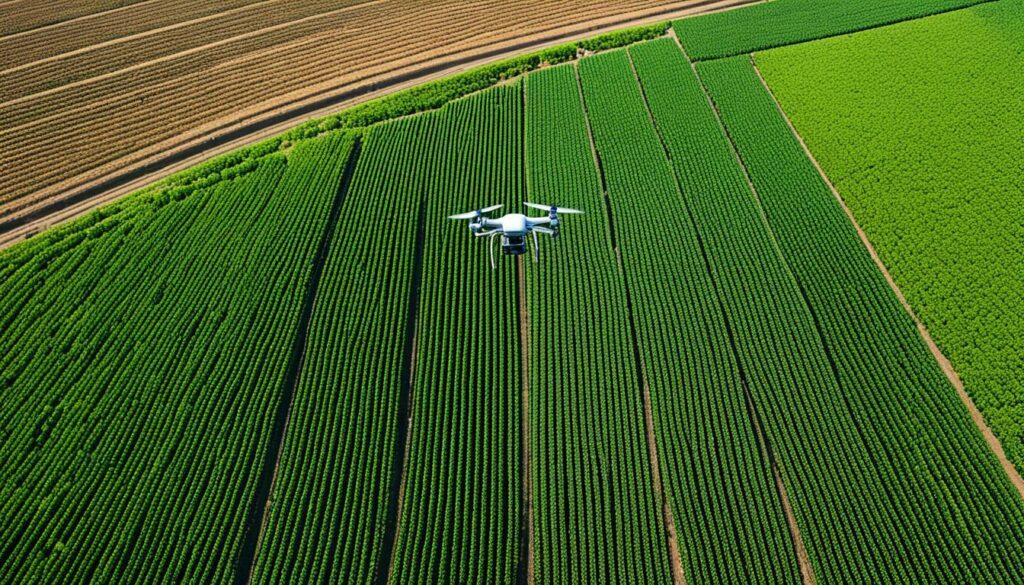
This technology uses GPS, drones, and satellite images for precise farming. It maps fields and spots plant problems. Then it puts seeds and fertilizers in the perfect places at the perfect times. This means crops grow well and there’s less waste. It uses resources better and makes crops healthier.
Precision agriculture brings many benefits. It cuts down on costs and makes growing food more efficient. Tools like John Deere Operations Center™ boost farm productivity and profit. These advancements also help protect the environment by using fewer pesticides and making the most of crops. It’s all about farming in a way that cares for the planet.
Since the 1990s, precision agriculture has advanced a lot from just GPS in tractors. It’s still growing and will keep changing. New technologies like IoT, AI, and robots are coming up. This tech helps farmers grow more food with less. It’s the future of farming, making it both effective and eco-friendly.
Future food security and protecting the environment rely on sustainable farming. Digital solutions help farmers boost productivity in a green way. This means we can grow more food without harming our planet.
The MasAgro project in Mexico is a great example. It increased crop yields and helped small farmers. By using the SRI method, they grew more rice with less water and chemicals.
Precision farming is changing agriculture, making it smarter and more efficient. This new way to farm uses data to make better decisions and manage resources well. But, not all farmers can try these new methods. Some face high costs or find it hard to change their old ways.
There’s a big debate about GMOs in sustainable farming. However, new tech like vertical farming and precision agriculture offer big benefits. They can make farming more productive and kinder to the planet.
Total Factor Productivity (TFP) is a key concept. It means we can grow more food using the same resources. This is good because it means we don’t need to use more land. But, from 2011 to 2019, this growth slowed down, forcing us to use new land.
Improvements in how we farm have been a big help. They’ve lowered poverty, made sure we have enough to eat, and protected our planet. In places like Sub-Saharan Africa, farming better has cut poverty and made food more available.
It’s critical to keep farming sustainably. This way, we protect resources and deal with climate change. Making farming greener by 2050 means we have to get a lot more efficient. Our goal is to farm in a way that helps both people and the planet.
We need to invest in knowledge, new ideas, and check that what we’re doing helps everyone. Looking ahead, farming smartly and using the latest tech will be key. This will help us tackle big problems and make sure there’s enough food in the future.
In today’s farming world, tools like the internet of things (IoT) and AI are changing how we farm. They bring data to the fields, making farming smarter. This new tech helps farms run better and produce more.
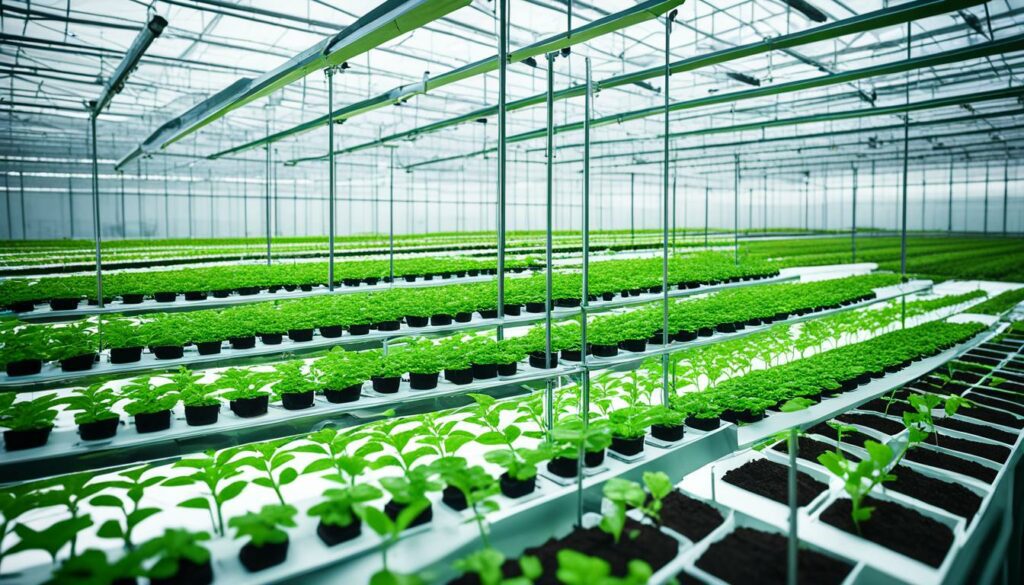
IoT in farming means keeping an eye on things in real time. Sensors watch soil, crops, and the sky. This helps farmers use water, fertiliser, and manage pests precisely.
AI helps farmers predict things, making their work easier. It’s great at spotting crop illnesses too. For instance, it can find apple black rot with over 90% accuracy.
AI drones and technologies like CattleEye look after the health of crops and animals.
AI also makes watering crops just right. It looks at soil and weather to decide when crops need water. This smart tech also helps in selling crops at the best times.
Put IoT and AI together, and you get farming that’s really clever. Such systems are crucial as we struggle to feed more people by 2050.
Managing agricultural data is key for today’s farmers. They must meet the food demands of a growing world. This is difficult since there’s not much more land to use.
The use of precise farming tools is booming thanks to a huge investment. These tools help track past and present data for smart farming decisions. This tech is changing farming, making it more productive while being kind to the environment.
Each year, a third of our food isn’t eaten, which is about 1.3 billion tons. This waste shows we must handle data better. There’s a big issue of who can be trusted with farm data. To solve this, some suggest a common ground to share data securely among farms. This could lead to better data use in agriculture.
The future of farming, especially in new economies, looks bright with digital farming tech. A major event in 2023 will present the best in farming tech and data use. This gathering hopes to boost farming’s efficiency and green practices.
Big companies like Microsoft are already helping farmers with smart data tools. They’re teaming up with others to make farming better with data-sharing. These collaborations aim to improve farming and lower its costs.
Good data management is vital for the success of high-tech farming. It lets farmers use digital tools effectively. This way, agriculture can be more eco-friendly and produce more food.
Farm management software changes how we do farming. It uses features like real-time monitoring and data analysis. These features help farmers work better, make more money, and use resources well.
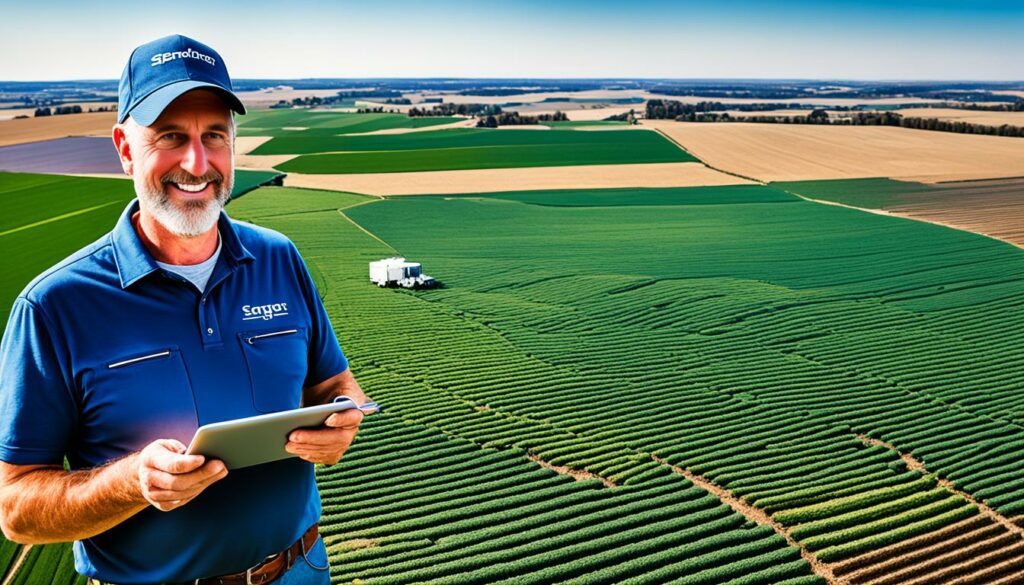
Today’s farm software does a lot to make farming tasks easier and smarter:
Take the MyCrops platform, for example. It has tools for many farming methods. It uses computer tech and deep learning to look at plant pictures. This helps farmers decide what to do next.
Many stories show how farm software can really change things. MyCrops is one good example. Experts all over praise it. They say it helps manage teams and make sure everything on the farm goes well.
In the cannabis world, people like MyCrops for tracking plant health and offering IPM help online. They find it easy to use and get help with it quickly. This makes managing farms much easier.
FarmERP is another software making a big difference worldwide. It serves over 30 countries and handles a lot of land.
In Nigeria, for example, FarmERP helped with huge farms. In Singapore and India, it made farming easier for many farmers. Plus, in South Africa, it helped lower pest problems for an avocado producer.
These stories show how farm software is changing the game in farming today. It’s making farms better, more eco-friendly, and more productive.
Agribusiness technology is changing how we see the agriculture value chain. It covers all farming stages like getting inputs, growing crops, and selling products. Digital solutions make each part more efficient. This includes dealing with farm inputs, the actual farming, post-production, and getting products to consumers.
“Agricultural data management lies at the heart of modern agribusiness technology, enabling enhanced productivity and connectivity among stakeholders.”
There are many challenges in the farming process. These include managing resources and improving how we farm. But digital tech like AI for watching crops, drones, and smart watering systems can help a lot. They make farming more precise and efficient.
More money is going into farm tech, with over US$4.6 billion spent in 2015. This has led to new inventions like self-driving tractors and better farming indoors. These developments help us tackle the challenge of needing to produce much more food by 2050. We have to do this with only a little more land available.
Using high-tech solutions in farming is key right now. They help farmers deal with the complexity of data and farming. These tools are not just good for the environment, they also make farming more profitable and ready for future challenges in food production.
In farming, the use of high-tech IoT solutions is rapidly growing. These smart tools are changing how we farm. They offer new ways to increase productivity and become more efficient.
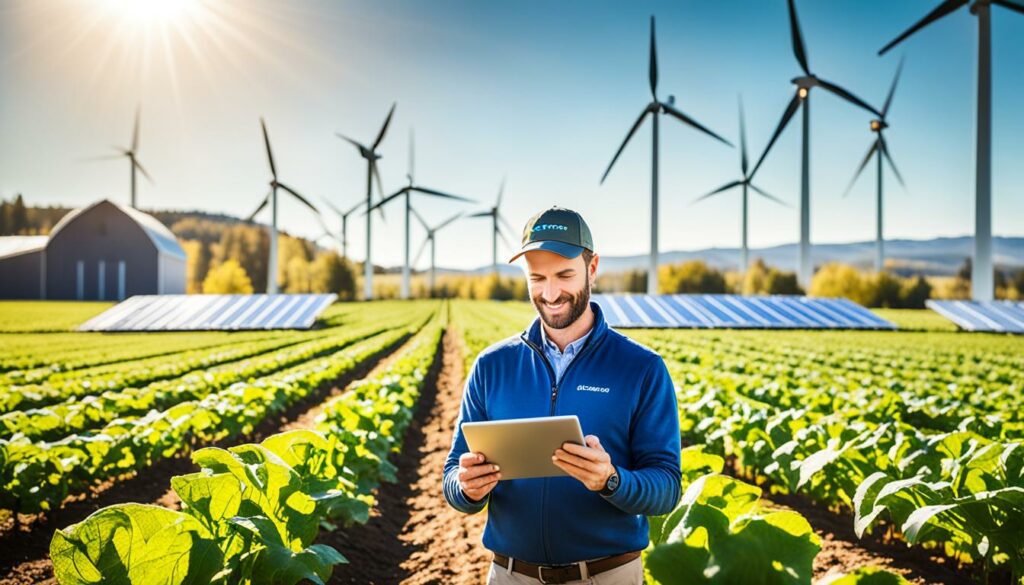
IoT is used in many ways in agriculture. One common use is sensors that monitor the environment. These sensors keep farmers informed about soil conditions, guiding better decisions.
Automation through IoT is also key. It helps in using farm resources precisely. This means making the most of what’s available while reducing waste.
Smart combines are a great example. They collect data from the field. This data helps farmers to plant crops more effectively and use resources better, leading to higher yields.
Soil sensors can cut down on costs. They show when and where to apply resources. This targeted approach means saving money.
IoT is changing farming for the better. It makes farming smarter and more efficient. With IoT, farms can make real-time decisions that improve their outcomes.
Thanks to IoT, farming is becoming more productive. Figures show that by 2030, the IoT market in farming could be worth over $78 billion. This growth shows how important these technologies have become for farmers.
80% of farms have already adopted IoT in some way. This shows that the industry is moving towards using data to farm better.
| Factor | Percentage Increase/Decrease |
|---|---|
| Efficiency | Significant Increase |
| Input Costs Reduction | Significant Reduction |
| Crop Yields | Increase |
| IoT Market Growth (2021-2030) | $30.51 billion to $78.85 billion |
The development of smart irrigation systems is changing farming for the better. These systems use digital technology to make the best use of water. They help save water, boost crop growth, and combat environmental problems. With these systems, water use can be cut by 30-50% while crop yields may go up by 20%.
Through real-time data from sensors, smart irrigation decides when and how much water to give crops. This efficient use of water is good for both the planet and the farm’s wallet. As a result, the market for such technology is growing fast. It’s set to jump from $1.2 billion in 2021 to $2.7 billion by 2027, with a yearly growth rate of 14.5%.
As farming uses 70% of the world’s fresh water, using smart irrigation is vital. The number of IoT devices in farming is expected to hit 225 million by 2024. This shows how important technology is becoming in agriculture. It’s key for using water better and growing more crops.
are a big step towards making farming smarter and greener. They are not just an upgrade but a must for sustainable agriculture.
| Benefit | Impact |
|---|---|
| Reduction in Water Usage | 30-50% |
| Yield Increase | Up to 20% |
| Market Growth | 14.5% CAGR (Projected to $2.7B by 2027) |
| Global Freshwater Usage by Agriculture | 70% |
| IoT Devices in Agriculture | 225 million by 2024 |
Drone technology is reshaping modern farming with its aerial insights. This includes enhanced practices in precision agriculture. The use of unmanned aerial vehicles (UAVs) is increasing. They are known for capturing detailed images. They also offer practical ways to manage farm resources.
For farming, two main drone types are used: rotary and fixed-wing. Rotary drones excel at being agile and are perfect for small to mid-sized farms. This is because they can take off and land vertically. On the other hand, fixed-wing drones suit large-scale farming better. They can cover more ground due to their endurance, speed, and larger coverage areas.
| Type of Drone | Best Applications | Advantages |
|---|---|---|
| Rotary Drones | Small to Mid-sized Farms | Vertical Take-Off, Precise Steering |
| Fixed-Wing Drones | Large-Scale Farms | Longer Flight Duration, Faster Coverage |
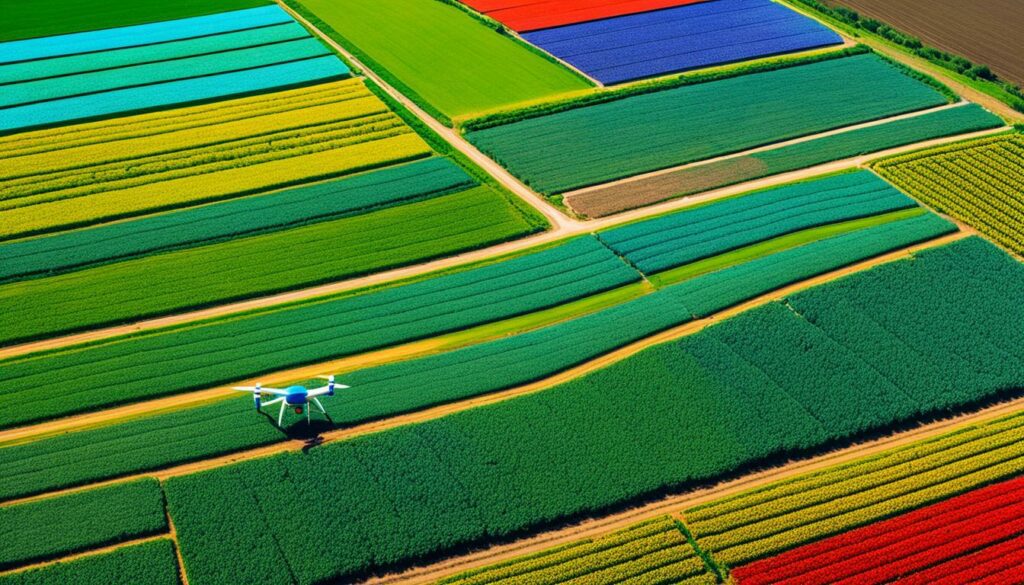
Aerial imaging from drones brings many advantages. High-quality cameras on drones spot plant stress early. This helps farmers act in time. The result is better use of water and other resources.
This approach improves crop health and harvests. Besides, drones are affordable and deliver good returns. They cost between $2 to $12 per acre, making them a smart choice.
Around 10% of farms use this technology. Yet, the outlook is bright. More farms are set to adopt AI-powered drones. They will find them invaluable and budget-friendly.
The global market for precise agriculture is on the rise. It’s expected to reach $43.4 billion by 2025. The drone market in agriculture is also growing fast. Predictions are at US$32.4 billion. This shows that drones are changing farming.
Digital farming platforms are changing agriculture by combining data from various sources. They merge financial and field records. This leads to better farm management through precision agriculture and smart farming methods.
Top digital farming platforms use IoT, sensors, drones, and cameras. This gives a full, real-time view of farming. For example, Cropin’s solution lets farmers monitor fields and tag locations in real-time. It also ensures data is kept safe and easily managed.
With xarvio® FIELD MANAGER now integrating with CNH Industrial’s platform, we see amazing results from working together. This shows how collaborations can make these platforms even more useful and widespread.
These platforms help manage farms by using predictive analytics and visuals. They’ve moved to a Software as a Service (SaaS) model. This makes them cheaper and easier to use than developing your own digital solutions.
Cropin’s team works hard to keep their system effective and updated. This means everyone from seed companies to big farms can use their applications well.
| Solution | Advantages | Challenges |
|---|---|---|
| IoT Setups | Real-time monitoring, Automation | Expensive, Complex to operate |
| SaaS Model | Scalable, Cost-effective | Initial adoption cost |
| Integrated Platforms | Holistic view, Better AI/ML insights | Data security, Management complexity |
Working together, digital farming providers and agtech giants like CNH Industrial have made precision farming easier for farmers. This means farmers using CNH’s equipment can manage their fields and do tailored tasks better.
AI technology is changing how we look at crops and their health. It’s a big step forward in helping farmers catch problems early. This means they can take action sooner to protect their crops. With sensors and smart software, we can spot any unusual signs in the crops. This helps farmers grow more food in a smarter, more sustainable way.
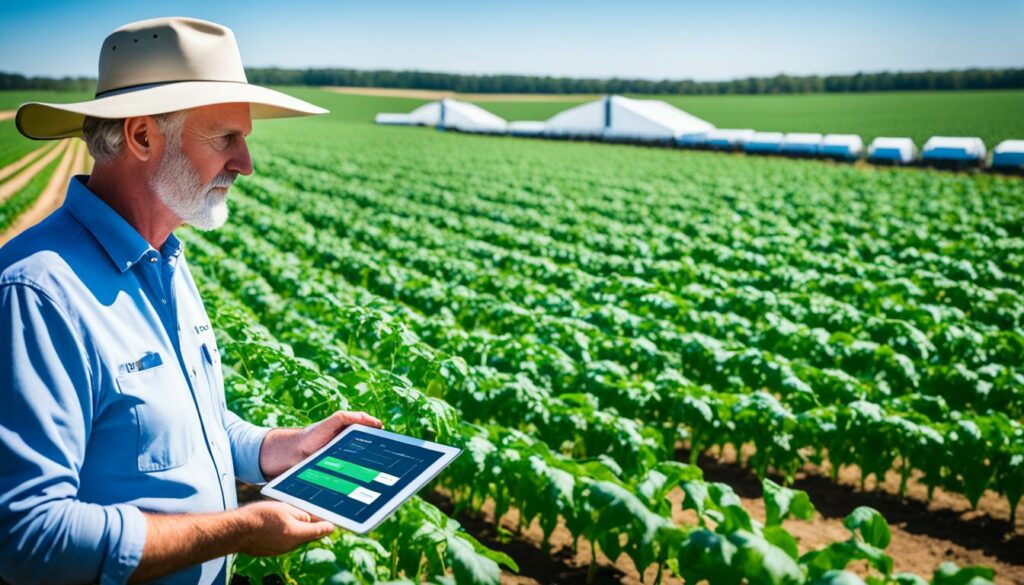
The world of AI in farming is growing fast. By 2025, it’s estimated to hit $2.6 billion. Today, AI is used for lots of things like fighting weeds, checking the soil, and keeping an eye on pests and diseases. These tools make farming more efficient. They save time and money while improving the quality of the harvest.
Many farmers now use drones to check up on their crops from the sky. In one study, drones helped find young, unripe citrus fruits that were sick. They did this using special software. This shows how drones and smart software can help catch crop diseases early. This means farmers can act fast, making their crops more resilient.
AI has a lot of promise when it comes to farming and keeping an eye on crops. With the world’s population growing, farming needs to be smarter and greener than ever. AI helps farmers make better decisions by giving them important data. This is key for making sure there’s enough food for everyone in the future.
The world of agriculture is changing rapidly, all thanks to some key companies. ICL Group and Idroplan are at the forefront. They bring new tech to farming, making it both more efficient and better for the planet.
ICL Group is pushing boundaries by using the latest tech in farming. They’re all about data and AI to help farmers grow more and waste less. Their solutions are tackling big issues like how to farm in a changing climate and keeping our food supply secure.
Idroplan specializes in making smart irrigation systems. They give farmers ways to use water smarter. By using real-time data, they help farmers water their crops the right amount. This not only means healthier plants but also less water wasted, ultimately boosting farm output.
Digital farming tools are changing agriculture in big ways. They bring smart solutions to farming. Things like smart sensors, drones, and machine learning help farmers a lot. They can watch soil, nutrients, and crops closely. This means they can make smarter choices and use their resources better.
Companies in digital agriculture lead this change. They offer ways to farm more precisely. They use technologies such as data analysis, GPS, and AI. These tools help farmers grow more and better crops. They also make planting, watering, and harvesting easier. This cuts down on the work needed.
In the future, farming with digital tools will be even better. We will farm in ways that are good for the earth. With IoT, satellite help, and blockchains, farming will be cleaner. It will use less water and fertiliser. This is better for the planet. The future of farming is in digital solutions that help grow more food safely. This change to digital farming is key for the future.
Digital farming merges tech with farming to address global issues like food shortage and sustainability. It uses precision agri-tech, smart tools, and software to boost farm performance. This way, it saves resources.
Agritech innovation makes farming more productive and earth-friendly. It uses data analysis, drones, and sensors to optimise farming. This approach helps the farming sector adjust and thrive against changing challenges.
Precision agriculture tech uses digital tools to smartly cultivate food. It combines data analysis, satellite pics, and sensors. This method boosts crop health and yields, cuts costs, and is eco-friendly.
Sustainable farming is key to secure food and protect our planet. By merging tech with farming, we can grow more food while saving nature. Thus, farming stays productive in the long term.
The Internet of Things (IoT) tracks and controls farm activities instantly. This smart tech uses sensors and devices. It creates farms that can change and adapt quickly as needed.
Managing farm data turns big datasets into helpful tips for farming. Farming platforms bundle past and real-time data. This knowledge leads to better decisions, smarter use of resources, and eco-friendly practices.
Today’s farm software checks on things, analyses data, and manages resources in real time. These help in running farms efficiently. They provide a hub for handling different farm activities smoothly.
Agribusiness tech links and boosts productivity along the farm-to-table chain. It tackles business issues from start to finish. These solutions make farming and food distribution more efficient, cooperative, and clear.
Innovative IoT solutions include sensors for checking the environment and automating machinery. They manage resources better and help make smarter decisions. These tools make farms more productive and efficient.
Smart irrigation uses sensors and data to water crops at the right time. This saves water, boosts crop yield, and helps the environment. It’s an intelligent way to farm.
Advanced drones give a bird’s-eye view of crops to see their health and manage resources well. They detect problems early, optimise water use, and help make better decisions. This increases farm productivity.
Digital farms bring together data for a full look at farm operations. They use predictive analytics and data display. This helps farmers tackle complex issues and manage farms better.
AI solutions use images from drones or satellites to spot crop issues. They find problems early and use smart strategies to safeguard crops. Technology plays a big role in looking after modern farms.
Companies like ICL Group and Idroplan lead in digital farming. They are top-notch in agritech and smart irrigation. Their tools are changing farming for the better, making it more sustainable, efficient, and productive.